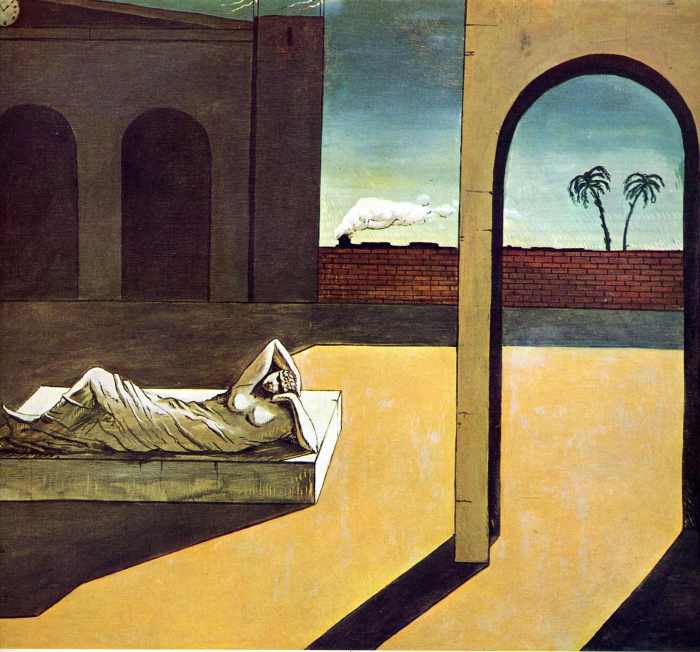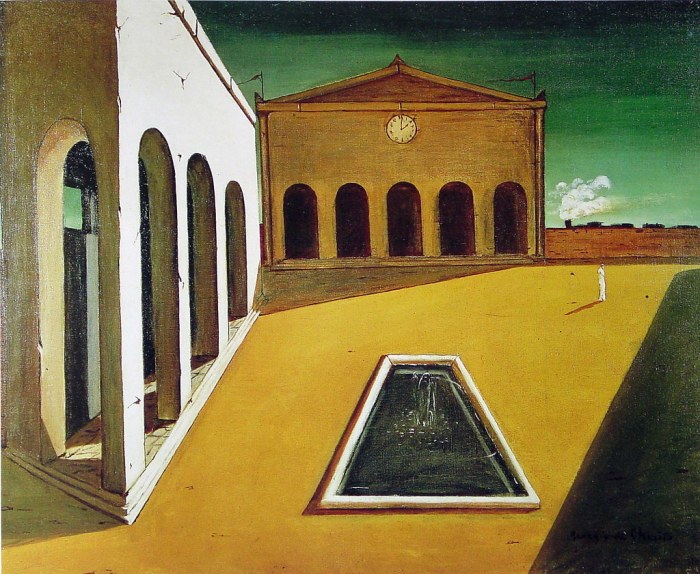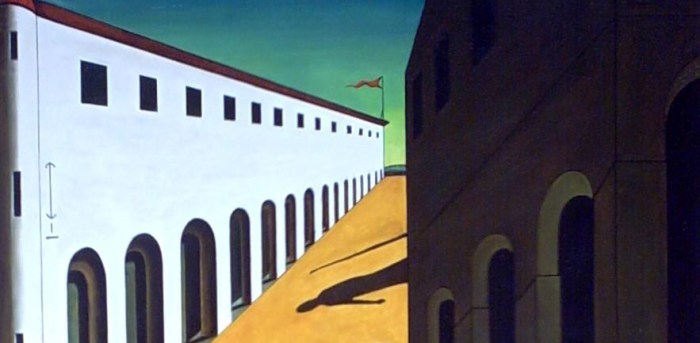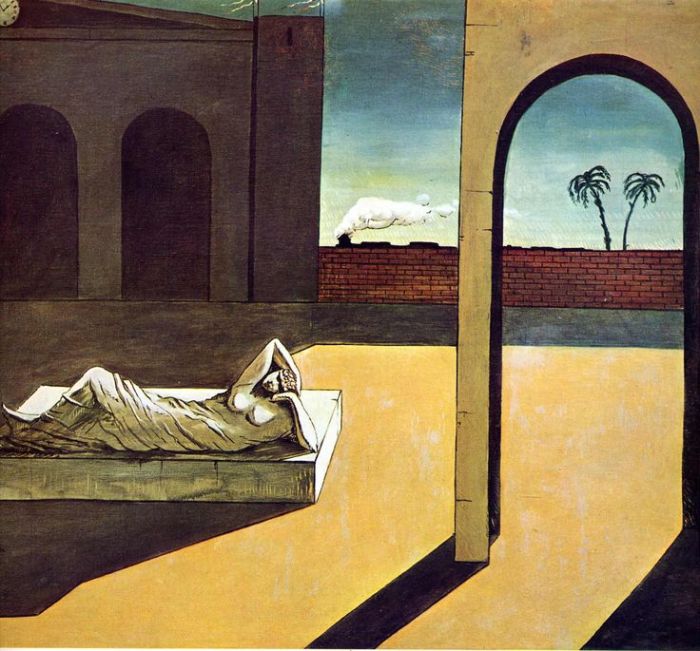Giorgio de chirico mystery and melancholy of a street – Giorgio de Chirico’s iconic painting, “The Mystery and Melancholy of a Street,” captivates viewers with its enigmatic atmosphere and haunting portrayal of urban isolation. This masterpiece exemplifies the artist’s unique style, characterized by sharp lines, geometric shapes, and muted colors, which evoke a profound sense of mystery and melancholy.
Through the juxtaposition of ordinary objects and architectural elements in unsettling and unexpected ways, de Chirico invites viewers to contemplate the hidden depths of urban life, revealing the alienation and loneliness that can lurk beneath the surface of everyday existence.
Artistic Style and Techniques: Giorgio De Chirico Mystery And Melancholy Of A Street

Giorgio de Chirico’s unique artistic style, characterized by sharp lines, geometric shapes, and muted colors, plays a pivotal role in evoking a sense of mystery and melancholy in his paintings. These elements contribute to a feeling of alienation and isolation.
Use of Sharp Lines and Geometric Shapes
- De Chirico’s paintings often feature sharply defined lines and geometric shapes, creating a sense of order and precision.
- The juxtaposition of these rigid forms with organic elements, such as figures or buildings, enhances the feeling of unease and disorientation.
- Example: “The Enigma of Arrival” (1914) showcases a desolate urban landscape with sharp architectural structures and a solitary figure, amplifying the sense of alienation.
Muted Colors and Atmospheric Perspective
- De Chirico’s paintings often employ muted and subdued colors, creating a sense of detachment and emotional distance.
- He frequently used atmospheric perspective, where distant objects appear less distinct and colors fade, further contributing to the mysterious and enigmatic quality of his works.
- Example: “The Melancholy of Departure” (1914) depicts a train station with muted earth tones and a hazy atmosphere, evoking a sense of nostalgia and longing.
Symbolism and Metaphor

De Chirico’s paintings are replete with recurring symbols and motifs that carry significant meanings, adding to the overall atmosphere of mystery and melancholy.
Shadows and Empty Spaces
- Shadows play a crucial role in de Chirico’s paintings, creating a sense of unease and uncertainty.
- Empty spaces, devoid of human presence, evoke a feeling of isolation and abandonment.
- Example: “The Song of Love” (1914) features a solitary figure in an empty square, overshadowed by a towering statue, conveying a sense of loneliness and existential angst.
Enigmatic Objects
- De Chirico often incorporated enigmatic objects into his paintings, such as mannequins, clocks, or toys.
- These objects, often placed out of context or in unexpected juxtapositions, add to the surreal and dreamlike quality of his works.
- Example: “The Dream” (1913) depicts a sleeping figure in a room filled with strange objects, creating a sense of disorientation and mystery.
Urban Landscapes and Isolation

De Chirico’s paintings frequently depict urban landscapes that contribute to the sense of mystery and melancholy.
Deserted Streets and Empty Squares
- His paintings often feature deserted streets and empty squares, evoking a sense of abandonment and alienation.
- The lack of human presence highlights the isolation and loneliness of the urban environment.
- Example: “The Melancholy of Departure” (1914) depicts a deserted train station, emphasizing the feeling of loss and longing.
Architectural Structures
- De Chirico’s paintings frequently incorporate architectural structures, such as towers, arcades, and columns.
- These structures, often depicted in a monumental or exaggerated manner, create a sense of awe and grandeur, yet also contribute to the feeling of alienation and insignificance.
- Example: “The Enigma of an Autumn Afternoon” (1910) features a towering tower that dominates the composition, dwarfing the solitary figures below.
Influence and Legacy

De Chirico’s work has had a profound influence on the development of Surrealism and other artistic movements.
Surrealism and Dreamlike Imagery
- De Chirico’s enigmatic and dreamlike imagery has been influential in the development of Surrealism.
- His exploration of the subconscious and the juxtaposition of unexpected elements inspired many Surrealist artists.
- Example: René Magritte’s “The Son of Man” (1964) shows the influence of de Chirico’s dreamlike and enigmatic style.
Influence on Contemporary Artists, Giorgio de chirico mystery and melancholy of a street
- De Chirico’s work continues to inspire contemporary artists who explore themes of mystery and melancholy.
- His use of symbolism and enigmatic imagery has resonated with artists such as David Lynch and Edward Hopper.
- Example: David Lynch’s film “Eraserhead” (1977) incorporates elements of de Chirico’s style, creating a surreal and unsettling atmosphere.
Common Queries
What is the significance of the empty spaces in de Chirico’s paintings?
The empty spaces in de Chirico’s paintings contribute to the sense of alienation and isolation by creating a feeling of vastness and emptiness. They suggest a world devoid of human presence, emphasizing the loneliness and insignificance of the individual.
How does de Chirico use light and shadow in his paintings?
De Chirico often uses contrasting light and shadow to create a sense of mystery and unease. The harsh sunlight casts long shadows, accentuating the geometric shapes and architectural elements, while the shadows themselves seem to take on a life of their own, adding to the disquieting atmosphere.
What are some of the recurring symbols found in de Chirico’s paintings?
De Chirico’s paintings often feature recurring symbols such as mannequins, clocks, towers, and trains. These symbols evoke a sense of timelessness and the transience of human existence, further contributing to the enigmatic and unsettling nature of his work.